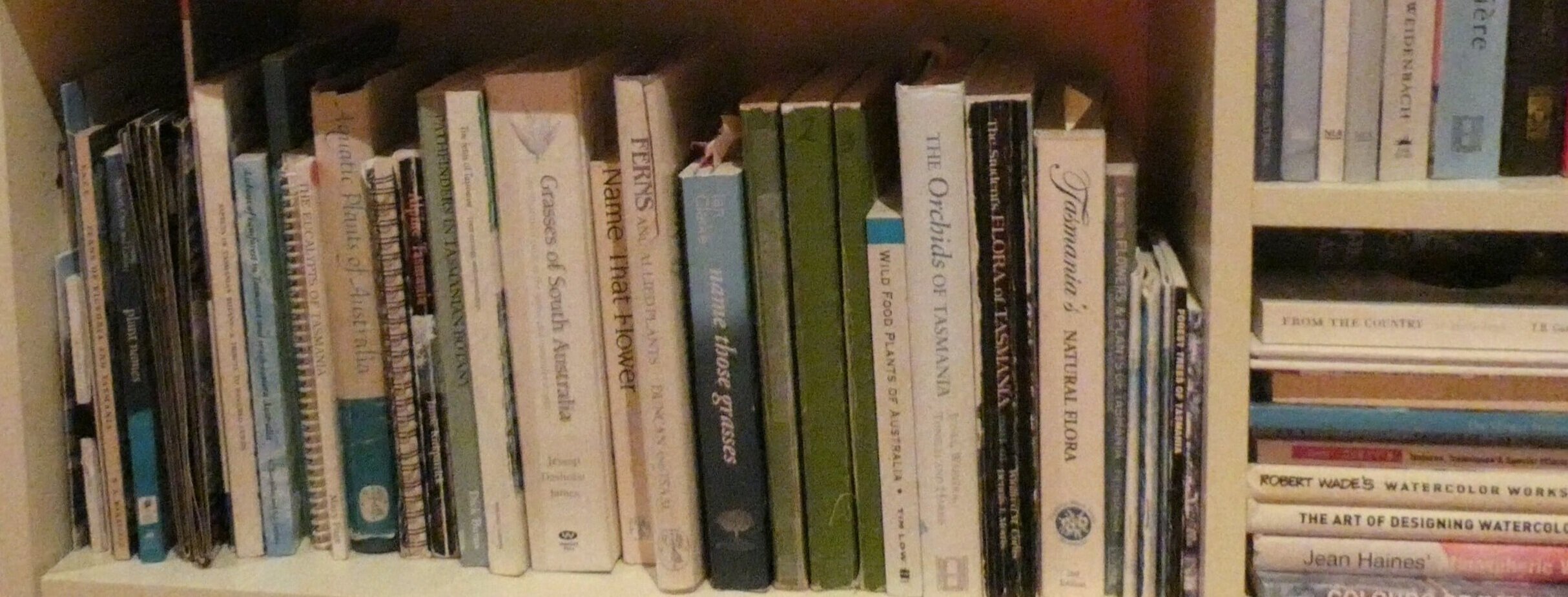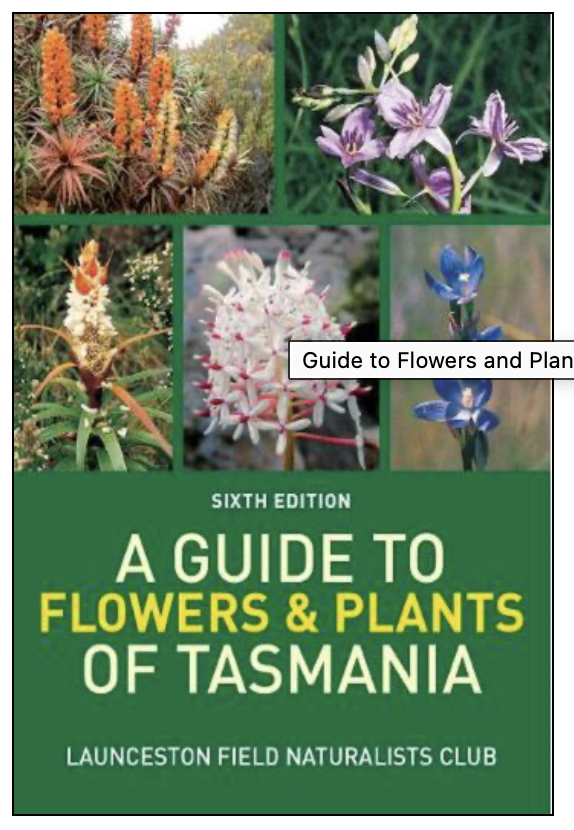
Publications
Publications on a wide range of subjects about or related to Tasmanian plants
APST Identikits
A series of pocket sized booklets of Tasmanian plants called Plant Identikits have been produced, by a project group consisting of artists, authors and advisory botanists, to aid field identification of plants. These booklets have been written by APST members with botanically correct illustrations drawn and hand painted also by APST members.
The series includes Wildflowers of Mount Wellington, Alpine Wildflowers, Woodland Wildflowers, Rainforest Plants, Orchids of Tasmania and Coastal Plants. Each booklet contains around 55 watercolour paintings and associated descriptive text.
Copies are available from selected bookshops and some Tasmanian National Park visitor’s centres or through APST Hobart Group’s publication officer, tasnatflora@gmail.com
Wildflowers of Mt Wellington
This booklet covers over 60 Tasmanian species found in Wellington Park behind Hobart, nearly half of which are endemic to Tasmania.
Alpine Wildflowers
This booklet covers over 50 high country species, the majority of which are endemic to Tasmania.
Woodland Wildflowers of Tasmania
This booklet covers over 50 Tasmanian woodland species, several of which are endemic to Tasmania.
Rainforest Plants of Tasmania
This booklet covers over 50 Tasmanian temperate rainforest species, nearly half of which are endemic to Tasmania.
Common Orchids of Tasmania
This booklet covers over 70 orchid species, many of which are endemic to Tasmania. It also provides location where they may be found when conditions are right.
Coastal Plants of Tasmania
This booklet covers over 50 coastal area species, some of which are endemic to Tasmania and a few others introduced to Australia.
Grow Local Guide
A Guide to Growing Local Plants - Southern Tasmania
Members’ publications - Dick Burns and Marion Simmons
Exploring the Flora of Cradle Mountain
Identikit - Day Walk Areas
Exploring the Flora of Cradle Mountain Day Walks Area is the first of a series of pocket size identikit booklets written by Dick Burns of the APST North West Group covering the significant and diverse flora of some of Tasmania’s National Parks. This booklet covers over 60 species found in the Cradle Mountain day walk area of the Cradle Mountain – Lake St Clair National Park and most are illustrated with excellent photos accompanied by simple descriptions and locations in the Park. Copies of this new edition are available from selected bookshops and the Cradle Mountain Park Visitor Centre or direct from the author, postal address: 17 Deviation Road, Penguin, Tasmania 7316.
A Cradle Mountain Companion
Our prolific author member, Dick Burns, has produced a companion book to his ‘Exploring the Flora of Cradle Mountain Day Walk Areas’ identikit booklet.
This excellent booklet:
lists the Geological Events in the Formation of Cradle Mountain,
has an easily understood Geology Primer,
discusses the formation of the Earth, the Earth’s Crust, the story of the Earth’s Crust and the Folding and Faulting of the Rock Beds with superb illustrations.
It then goes on to discuss the rocks of Cradle Mountain before detailing the Forming of Cradle Mountain with more beautiful illustrations.
This new book concludes with the ‘Geology along the popular tracks’ again with excellent pictures for illustrations.
A Guide to the Flora of Freycinet National Park
Identikit - A Guide to the Flora of Freycinet National Park, is the second of a series of pocket size identikit booklets written by Dick Burns of the APST North West Group covering the significant and diverse flora of some of Tasmania’s National Parks. This booklet covers over 100 species found in the Freycinet National Park and most are illustrated with excellent photos accompanied by simple descriptions and locations in the Park. Copies are available from selected bookshops and the Freycinet Park Visitor Centre or direct from the author, postal address: 17 Deviation Road, Penguin, Tasmania 7316.
Wattles of Tasmania
Marion Simmons OAM
Published in 2009, this small book is a compilation of the 20 Tasmanian Wattle species that Marion Simmons had previously described and illustrated in her definitive Acacias of Australia, Volume 1 (first published 1981). This book and its pair, Volume 2 cover 300 of the over 1,000 Australian Wattle species identified and described to date. The current book is an excellent guide to identifying and growing Tasmanian Wattles with each of the 20 species accurately illustrated with a black and white line drawing on the right hand page and fully described on the opposite page. Additional information is provided on the flammability, propagation by seed and cuttings, and growing in containers. Four Mainland Wattle species that are potential weed species have also been illustrated and described with warnings not to grow near bushland or forestry areas. Self-published, this excellent reference booklet is available from Blackgum Distribution Services.
Tasmania’s Natural Flora
APST Hobart Group
Editor Christine Howells
This excellent book covers over 700 species of Tasmanian flora, mostly flowering plants, but it also includes all the conifers, a few lilies, no grasses, ferns, mosses and their allied groups nor any orchids. Each species is described in layman terms covering: size, shape, leaf and flower forms, flowering time, fruit form, habitat and distribution, and cultivation. It is an ideal reference book for anyone interested in Tasmanian flora.
Copies are available from selected bookshops or through APST Hobart Group’s publication officer at tasnatflora@gmail.com
A Guide to Flowers & Plants of Tasmania
Launceston Field Naturalists Club
Guide to Flowers and Plants of Tasmania has been a mainstay for people interested in identifying Tasmanian plants. First published in the 1970’s, to quote the Introduction, “It is impossible to feature all the flowering plants, so a representative sample of those easily seen has been chosen. Many are common and widespread, others are significant parts of the Tasmanian flora, either confined to Tasmania or examples of genera more richly represented in Tasmania than in other states.” Published and sold by the Launceston Field Naturalists Club Inc. postal address: 23 Skemps Road, Myrtle Bank, Tasmania,7259.
Copies are also available at selected bookshops throughout the state.













